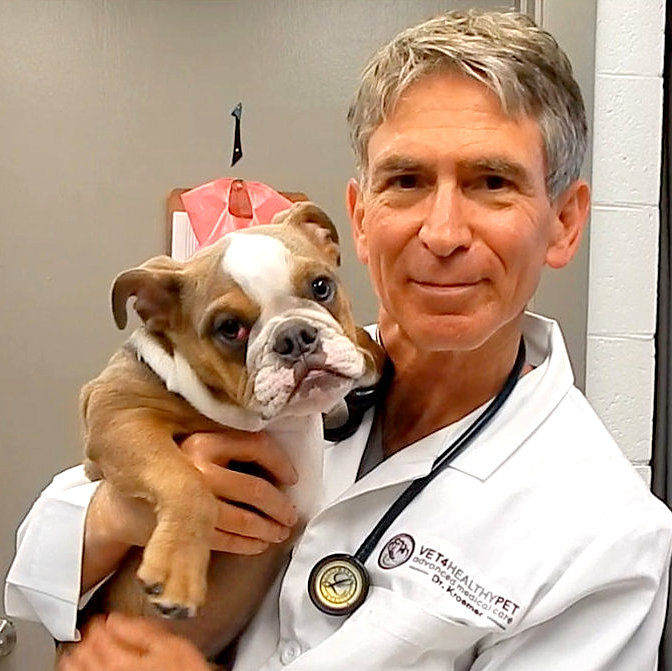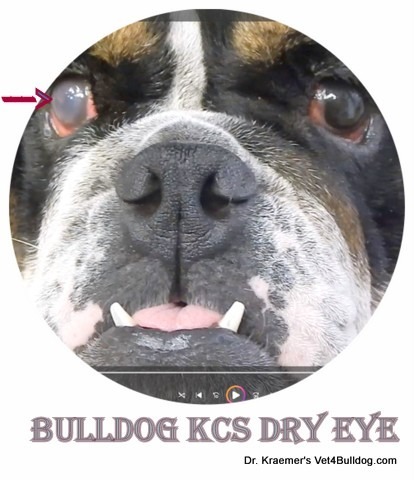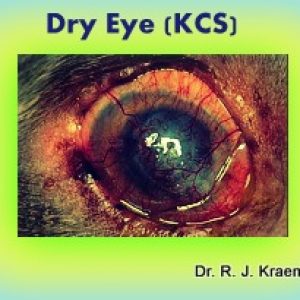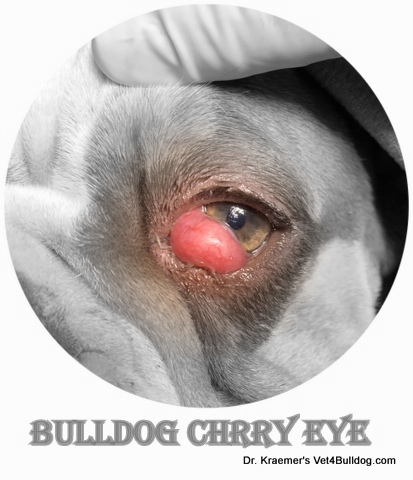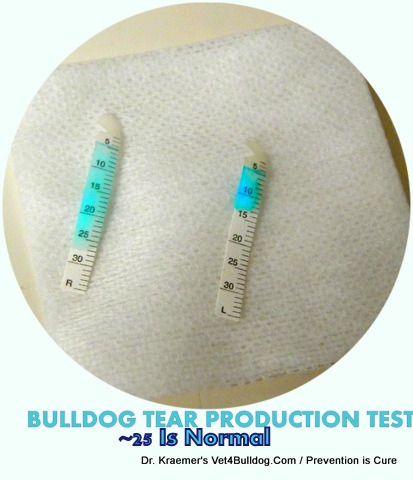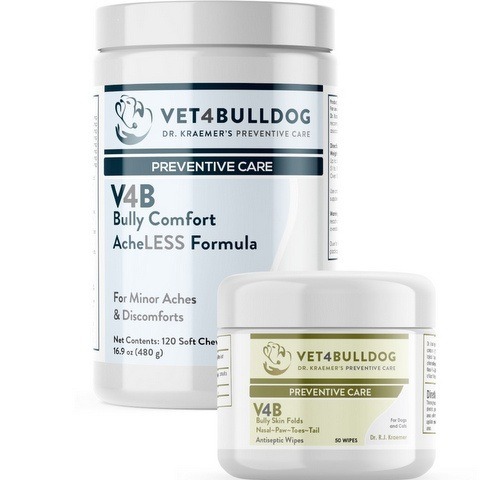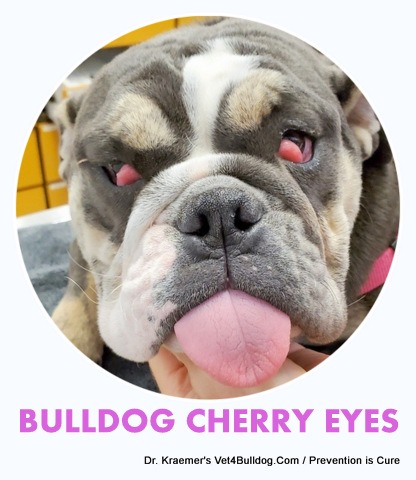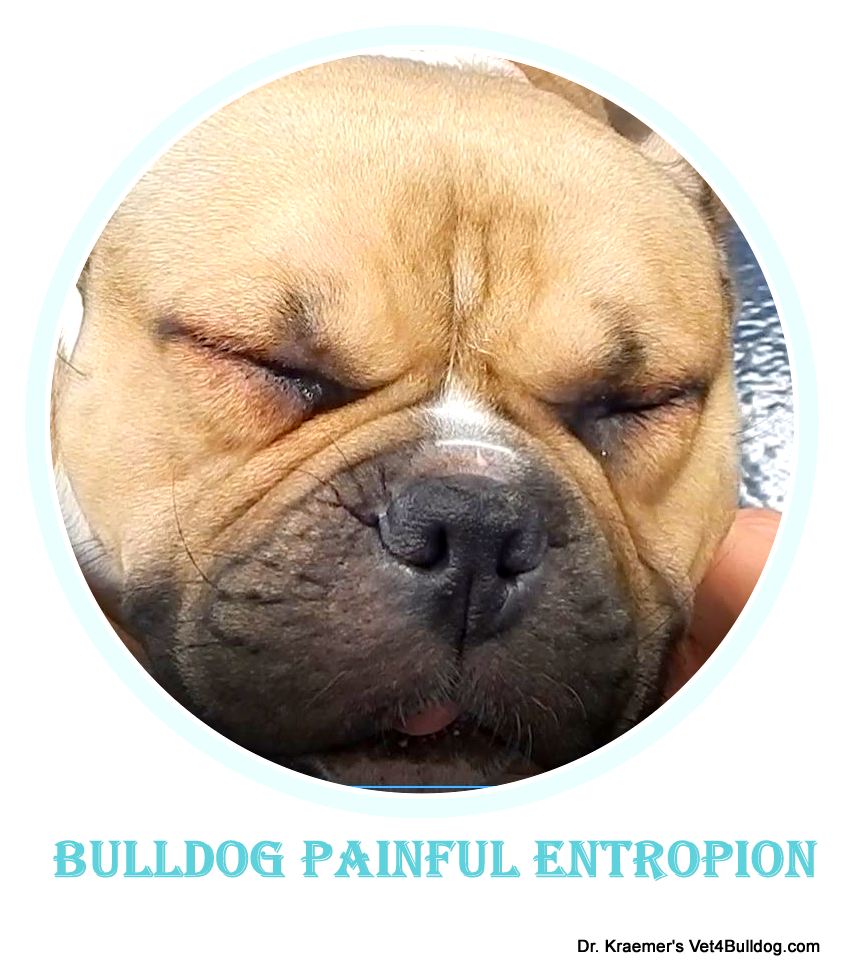Dr. Kraemer, my sweet 5-year-old sweet English Bulldog rescue, George, has a white layer covering his eyes along with visible blood vessels. He also seems to be losing some vision. I’m worried 💔—please advise.
Introduction to Bulldog and French Bulldog Dry Eye (KCS)
Keratoconjunctivitis Sicca (KCS), or “Dry Eye,” is a common ophthalmic condition in bulldogs and French bulldogs. It is characterized by chronic inflammation of the:
- Ocular surface
- Conjunctiva (the pink tissue around the eye)
- Cornea (the clear, outermost part of the eye)
- Sclera (the white part of the eye)
This condition leads to insufficient tear production, causing irritation, discomfort, and potential vision loss if left untreated.
Bulldog Dry Eye KCS 5 X MUST KNOW
- Bulldog dry eye is due to a decrease in tear production, mostly due to an autoimmune disease
- Schimmer Tear Test is the gold standard to help diagnose Keratoconjectivitis Sicca (KCS)
- KCS can lead to cornea ulcers and sight loss
- Dry eye is usually treated with a combination of topical opthlamic medication.
- Prevention includes Dr. Kraemer’s Dry Eyes Care Bundles
An Once of Prevention is Worth a Pound of Cure
What is Bulldog KCS (Dry Eye)?
KCS (Keratoconjunctivitis Sicca) is a condition that causes chronic dryness and inflammation of the eye’s surface, including the conjunctiva (the membrane covering the eye) and the cornea (the clear outer layer).
➡️ It is less common in French Bulldog and English Bulldog puppies and more common in adult and senior bulldogs
➡️ Bulldog dry eye often affects both eyes, but it may start in one eye and later develop in the other.
What is the Tear Film in Bulldogs and French Bulldogs?
Your bulldog’s tear film is essential for maintaining eye health and comfort. It consists of three layers, each with a crucial function:
➡️ MUCIN Layer (Inner Layer): Helps stick tears to the cornea, ensuring even distribution.
➡️ LIPID Layer (Outer Layer): A thin, oily layer that prevents tear evaporation and maintains moisture.
➡️ AQUEOUS Layer (Middle Layer): The watery component of tears.
🚨Disruptions in any of these layers can lead to bulldog dry eye (KCS), causing discomfort and potential vision problems.
The tear film contains vital nutrients and provides essential lubrication to protect the cornea.
What Causes Dry Eyes KCS in Bulldogs and Fr. Bulldogs?
The dryness is usually due to decreased tear production
#1. IMUNNED MEDIATED KCS
In bulldogs and French bulldogs, dry eye is most often an immune-mediated disease (autoimmune).
#2. KCS OTHER CAUSE:
- TRAUMA: Trauma to the bulldog’s eye, skull, or orbit.
- NEUROLOGIC CAUSE: An injury to your bulldog’s cranial nerve 7 (facial nerve paralysis) or CN5 (trigeminal nerve).
- DRUG INDUCED: (Sulfa Drugs, see “tips & warnings”).
- HORMONAL DISEASE: Such as Bulldog Hypothyroidism.
- CHERRY EYE REMOVAL: The cherry eye must be preserved when repaired due to prolapse.
Inadequate tear production and dryness of the eyes can lead to
- Painful corneal inflammation
- conreanl scarring
- conrneal ulcers
- vision impairment.
BULLDOG KCS CHERRY EYE WARNING 🚨
Up to 30% of the aqueous (watery tear film) part is produced in the nicotinic member, better known as the bulldog cherry eye. Therefore, the surgeon operating on it must preserve the cherry (nicotinic membrane with gland).
⚠️ Removing the cherry could lead to a bully dry eye or exasperate it
Dry Eyes KCS Symptoms in Bulldogs and French Bulldogs:
Most bulldogs with KCS present with a history of chronic, recurrent, nonspecific keratoconjunctivitis.
Here is a list of the most common findings noted with bully dry eye:
➡️ DISCHARGE: Mucoid chronic d/c
➡️ REDNESS: Red injected conjunctiva and sclera
➡️ FOGGY CORENA: Discolored, pigmented, vascular, and fibrotic cornea (should be clear)
➡️ INFECTION: KCS can break down the corneal protective barriers, thus predisposing your bulldog to secondary bacterial conjunctivitis.
➡️ BLINDNESS: partial or complete loss of vision.
Low tear production leads to corneal hypoxia and corneal dehydration.
Diagnosing Bulldog Dry Eye (KCS)
A straightforward tear production test called the Schirmer Tear Test is used to measure your bulldog’s quantitative tear production.
#1 Schirmer Tear Test
AQUEOUS / QUANTITATIVE: This test assesses the aqueous (watery) component of the tear film, which is the only part measured.
MUCIN / QUALITATIVE: The mucin and lipid layers, which contribute to tear quality and stability, are not evaluated by this test.
The Schirmer Tear Test is a quick and simple way to measure tear production. A narrow strip of paper is placed in the eye for 1 minute, absorbing tears.
💧 The more blue on the strip, the better the tear production.
Interpreting the Results:
✅ Normal: ≥ 20 mm wetting per minute
⚠️ Early KCS: 15-19 mm wetting per minute
⚠️ Mild KCS: 11-14 mm wetting per minute
⚠️ Moderate KCS: 6-10 mm wetting per minute
❌ Severe KCS: <5 mm wetting per minute
⚠️ KCS Diagnosis Warning
In the early stages of your bulldog’s dry eye (KCS), mucin and lipid production may be low, while aqueous tear production can still appear normal. The Schirmer Tear Test only measures the aqueous component, meaning results may falsely appear “normal” even when clinical signs suggest bulldog KCS.
🩺 Before diagnosing and starting appropriate bully dry eye treatment, an experienced bulldog veterinarian will consider
- all tear film components
- The clinical symptoms
- and breed-specific risks
#2. Cornea Fluorescein Stain Test
Your veterinarian will perform a fluorescein stain test to check for an active corneal ulcer.
- A special fluorescein dye is applied to your bulldog’s cornea.
- The eye is then examined under a UV light in a dark room.
- Any damaged or ulcerated areas will glow green, confirming the presence of an ulcer.
This test is essential for diagnosing corneal injuries, which are common in bulldogs due to their prominent eyes
Preventing & Treating Bulldog and French Bulldog Dry Eye (KCS)
✔️ Step-by-step Care Guide:
➡️ REMOVE MUCUS: Clean the eyes to remove debris and mucus. Use a simple, inexpensive OTC hypotonic eyewash (sterile water works well).
➡️ MEDICATIONS
💊 IMMUNE SUPPRESSANTS: Topical ophthalmic ointments or drops like
- Cyclosporine
- Tacrolimus
-help manage dry eye by suppressing the immune response.
💊ANTI-INFLAMMATORY: Medications such as
- ophthalmic hydrocortisone
- dexamethasone
-Helps reduce inflammation.
💊 ANTIBIOTICS: Short-term topical antibiotics may be required in cases of infection.
💊 LUBRICANTS: Opt for lubricants containing hyaluronic acid, which can be effective in managing early-stage Bulldog KCS.
⚠️ Important Steroid Caution in Bulldog Dry Eye Treatment
🚨Ophthalmic steroids help reduce KCS inflammation but can worsen an active corneal ulcer.
🚨Before using any dry eye medication containing steroids, your vet should always perform a corneal stain test to rule out ulcers.
🚨Using steroids without confirming the absence of an ulcer can lead to delayed healing, corneal thinning, and worsening of the condition.
Dr. Kraemer’s Bulldog & French Bulldog Dry Eye Rule of Thumb
🩺Lifelong Treatment: To protect your bulldog’s cornea, prevent vision loss, and manage discomfort, dry eye treatment must be applied daily for life.
🩺Tear Testing Tip: Always test your bulldogs’ tear production whenever they experience an eye problem, especially if a corneal issue is suspected.
Early detection ensures proper management and better long-term eye health.
Dry Eyes in Bulldogs and French Bulldogs: KCS Tips & Warnings
Below are selected tips and warnings courtesy of Dr. Kraemer
#1 🩺 Bulldog Dry Eye OTC Opthalmic Lubricants Tip :
Over-the-counter lubricants and irrigating eye drops can be used in addition to prescription treatments but should not replace them.
Preferred Option: Choose lubricants containing hyaluronic acid, as they provide better moisture retention and protection for your bulldog’s eyes.
#2 🩺 Bulldog KCS Eye RX Tip:
Cost Awareness: Some prescription dry eye drops can be expensive, so avoid waste—one drop per eye is sufficient.
💧 Drops vs. Ointments:
- ✔️ Preferred: Drops – easier to apply and control.
- ❌ Ointments: Pressurized tubes can be difficult to manage and may lead to overuse.
#3 🩺 Bulldog and Fr. Bulldog Oplthamic Rinse Tip:
Clean First for Best Results
Before applying prescription eye drops, always remove mucus and debris using sterile water or a clean wipe. This ensures better absorption and effectiveness of the medication.
#4 🩺Bulldog and Fr. Bulldog Cherry Eye Tip:
Surgical Recommendation: Surgically correct your bulldog puppy’s cherry eye as soon as possible.
Delaying surgery can lead to chronic corneal irritation, discomfort, and potential long-term eye complications.
✅ Early intervention helps protect your bulldog’s vision and eye health.
#5 🩺 Bulldog KCS Autoimmune Disease Tip
Immune-mediated KCS should be your presumed underlining cause.
#1⚠️ Bulldog Cherry Eye Warning:
Do NOT remove the gland! Surgically removing your bulldog puppy’s cherry eye can lead to bulldog dry eye (KCS) because the gland contributes to aqueous tear production.
Instead, corrective surgery is recommended to reposition the gland and preserve tear function, reducing the risk of lifelong dry eye disease.
#2⚠️ Bulldog Dry Eye Warning Steroid Warning:
Do NOT use ophthalmic steroids on an active corneal ulcer—they can delay healing and worsen the condition.
Always consult your veterinarian before using steroid-containing eye medications to ensure they are safe for your bulldog’s specific eye condition.
#3⚠️ Dry Eye Commitment to Treatment Warning:
Neglecting treatment can result in:
- Progressive corneal damage
- Chronic pain & discomfort
- Frequent infections
- Impaired or complete vision loss
✅ Bulldog dry eye treatment must be applied DAILY for the rest of your bulldog’s life to maintain eye health and comfort.
#4⚠️ Sulfa RX Causing Bulldog KCS Warning:
Sulfa drugs can induce dry eye (KCS) and should be prescribed with caution or avoided when possible.
If prescribed:
- Check tear production before starting treatment.
- Recheck tear production after 5 days to monitor any adverse effects.
✅ Early detection helps prevent irreversible tear gland damage and long-term eye issues.
#5⚠️ Car Open Windows and KCS Warning:
Do NOT let your bulldog puppy stick their head out of the car window 🚗—this exposes their eyes to debris, wind, and injury.
If you allow it, use protective goggles to shield their eyes from dust, dirt, and potential trauma. Safety first!
#6⚠️ Antihistamines and Dry Eyes Risks Warning:
Antihistamines like Benadryl can reduce tear production, potentially worsening bulldog dry eye (KCS).
Use with caution, especially in bulldogs already prone to dry eye. If needed, monitor tear production and consult your vet for safer alternatives.
#7⚠️ Visine and Bulldog Dry Eye Warning:
Do NOT use Visine tear lubricants on your bulldogs—they cause vasoconstriction, which can lead to rebound redness and worsening of dry eye (KCS) over time.
Instead, use veterinary-recommended lubricants, preferably those containing hyaluronic acid, for safe and effective moisture retention.
#8⚠️ French Bulldogs and Bulldogs Opposite Eye Warning:
If one eye develops dry eye (KCS), the other is at high risk of developing tear deficiency over time.
Regular Monitoring: Even if only one eye is affected, the other eye should be checked frequently to catch early signs and start treatment if needed.
#9 ⚠️ Bulldog Cornear Ulcer Testing Warning:
- Schirmer Tear Test (STT) – Measures tear production to diagnose dry eye (KCS).
- Cornea Staining Test – Detects corneal ulcers, which can be missed if only the STT is performed.
✅ Always combine both tests to ensure a thorough evaluation of your bulldog’s eye health.
#10⚠️ Bacterial Conjunctivitis Misdiagnosis Warning
Some veterinarians mistakenly diagnose bulldog dry eye (KCS) as bacterial conjunctivitis, leading to incorrect treatment.
- A misdiagnosis can create a false sense of security
- Delays proper treatment, allowing the condition to worsen
- Untreated dry eye can lead to blindness
Prevent Misdiagnosis:
- Always request a Schirmer Tear Test (STT) and Corneal Stain Test when your bulldog has eye redness, discharge, or irritation.
- Work with an experienced bulldog veterinarian to ensure accurate diagnosis and appropriate treatment.
Recommended by Owners Approved by Bulldogs



